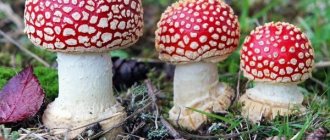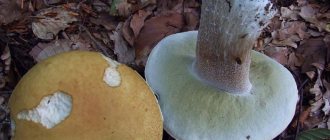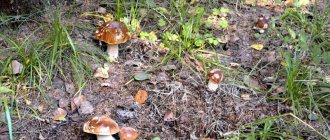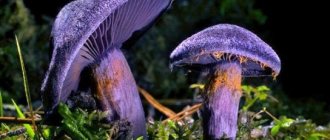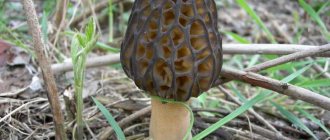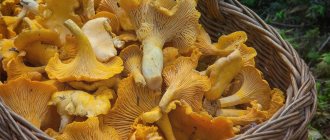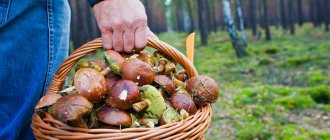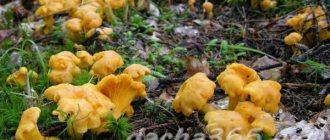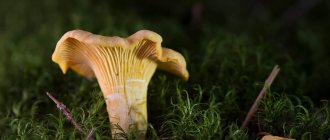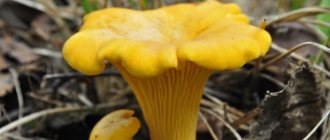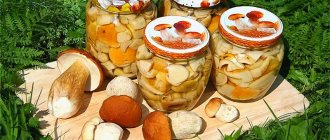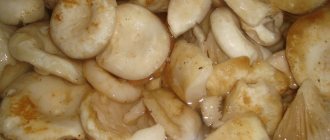The pale chanterelle, or as it is called “white chanterelle,” is a species of yellow chanterelle commonly found in Russian forests. Due to its appearance, it received the name white chanterelle, which is true. This mushroom is very beautiful, harmless, and most importantly tasty and edible. Belongs to the department of basidiomycetes, department of agaricomycetes, class agaricaceae, order chanterelles. Genus: fox. Cantharellus pallens - from Latin.
What are these representatives of the fungal kingdom?
What do white chanterelles look like?
The white or pale chanterelle mushroom belongs to the Chanterelle family. From the photo you can see that this is a species of yellow common chanterelle.
A distinctive feature of the white chanterelle is its cap. It is wavy, has uneven edges, and is funnel-shaped. Although these differences do not appear immediately. Next to adult mushrooms you can see young fruiting bodies whose caps are completely even. Gradually they curl upward. The diameter of the cap reaches 1-5 cm, but when weather conditions are favorable, specimens with a diameter of up to 8 cm can be found. The color of the fruiting body is uniform, from pale yellow to fawn.
The leg of a real white chanterelle is thick, cream or pale yellow in color. Its thickness is in the range of 0.5-1.5 cm. The length of the leg is up to 2.5 cm. It is clearly divided into lower and upper parts - this is a characteristic feature of the species. The bottom has a pronounced cylindrical shape, and towards the top it gradually expands and becomes cone-shaped.
The body of the mushroom is lamellar. The plates are large, dense, and are located on the inside of the cap. Smoothly transitions into the leg. The flesh is dense, colored the same color as the cap. The spores are golden in color.
Edibility
Pale chanterelles belong to the 2nd category of edibility. Despite the terrifying name, which many immediately associate with the pale grebe and its poisonousness, pale chanterelles do not pose a danger to human health. Moreover, this type of mushroom is tasty and healthy. The pale chanterelle (Cantharellus pallens) is in no way inferior in taste to ordinary yellow chanterelles.
The benefits and harms of white chanterelles
The pale or white chanterelle mushroom is very beneficial for the body. Infusions, powders and various extracts are made from it, which have the following properties:
- remove toxins and waste;
- suppress the growth of cancerous tumors;
- normalize blood pressure;
- destroy parasites and helminths in humans;
- contribute to the treatment of hepatitis;
- strengthen the walls of blood vessels;
- regulate blood sugar levels;
- normalize the functioning of the heart and thyroid gland;
- normalize liver function;
- treat colds and sore throats;
- pull out abscesses and boils;
- improve vision;
- promote weight loss and muscle growth.
However, before treatment, you must consult with your doctor and study all contraindications. Only false chanterelles or improperly prepared ones can cause harm.
However, beneficial mushrooms remain prohibited for pregnant and lactating women, and for children under 7 years of age. Those who have an individual intolerance to the product should not eat them.
Attention! Mushrooms are difficult to digest food; they should be used with caution in case of kidney diseases and gastrointestinal disorders.
Interesting Facts
Cantharellus pallens.
Chanterelles, including the white chanterelle species, are characterized by the following features:
- Due to the presence of the anthelmintic substance quinomannose in chanterelles, these mushrooms do not contain worms.
- Due to the presence of quinomannose, dried chanterelles can be used as an anthelmintic.
- Fungicidal and antibacterial components were also found in chanterelles.
- Due to their low calorie content and high protein content, chanterelles can be included in the diet.
- According to some sources, chanterelles are able to rid the body of radionuclides.
The pale chanterelle has good nutritional qualities and can be used in cooking in the same way as other edible chanterelle species. However, some people do not want to eat mushrooms: children (due to the immaturity of the digestive system, it is difficult for them to digest such food), allergy sufferers (mushrooms are often allergens) and people with diseases of the stomach and intestines.
Collection rules
Although chanterelles are edible, they should not be eaten if they were collected incorrectly or in the wrong place. You cannot collect them near industrial areas, as they accumulate heavy metals and other harmful substances. For the same reason, they are not collected near roads or highways.
So, it is clear that you need to collect in clean forests. Moreover, first of all you need to pay attention to the condition of the fungus. The edible white fruit is not wormy. This is due to the fact that its pulp is poisonous to worms and other parasites, but absolutely safe for humans.
To avoid mistakes when collecting white chanterelles, it is recommended to watch a video that clearly shows what it looks like.
White chanterelles grow in summer, but they can also be found in mixed forests in autumn. Mass collection occurs in the summer months: June, July, August. Of course, in September and October they can also be collected, but not so many. During periods of heavy rains, they do not rot, but retain their original appearance. But on dry days they stop growing.
To collect a lot of white chanterelles, you will have to work hard. After all, they love to hide under pine needles and fallen leaves. But if you find at least one mushroom, there will definitely be more nearby, you just need to carefully inspect the place. They grow in groups, sometimes forming large clearings.
High-quality white fruits suitable for harvesting have no damage, mold or plaque, or various stains on the caps. There is no need to take fruiting bodies if they are limp, soft, dry.
Attention! Transporting white chanterelles is very easy. They don't break down on the road.
Growing at home and in the country
White chanterelle mycelium is quite difficult to find in stores, but some companies offer it for planting in garden plots. Growing this type of mushroom will not work without oak, beech, pine or spruce. Mycorrhiza formed with the roots gives them nutrition and moisture to the tree. Garden representatives are not suitable for these purposes.
The simplest and most reliable method is to dig up a mycelium in the forest and plant it under a selected tree on the site. This will help the foxes move through space without inconvenience, while remaining in their familiar environment. Best grown under young plants.
For proper landing you need:
- dig a hole 20 cm deep and at least 15 cm in diameter;
- place in it the mycelium brought from the forest with soil;
- cover the top with moss, pine needles or fallen leaves.
It is desirable that the tree be of the same type as the one under which the mycelium was dug up. It is best to plant in summer. The fruits will appear next year.
If you bought mycelium in a store or online, you must follow the manufacturer’s recommendations during cultivation, then the plantation will bear fruit for several years and produce a large harvest.
False doubles of white chanterelles
White chanterelles have doubles - false inedible mushrooms. Externally, they differ from useful ones:
- The color of the false mushroom is bright. There are specimens in blood red, copper, orange, black and bright yellow.
- The shape of the cap of the inedible variety is smooth around the edges, with pronounced boundaries.
- The leg is clearly separated from the cap, thin and smooth.
- The pulp of the false mushroom retains its color when pressed.
In addition, poisonous twins grow singly, can be wormy, and smell unpleasant.
The most common poisonous look-alikes are the black and humpback chanterelles. The first type can be found quite rarely. His hat is charcoal-colored, without characteristic folds. The second type is more common, especially in mossy places. It is considered conditionally edible. Fruits from August until frost.
Similar species
The fox is false.
The pale chanterelle is similar only to the false chanterelle . The latter is poisonous in its raw form. The false chanterelle is distinguished by its intense orange color, as well as a thinner leg, which also has a cavity inside (while the pale chanterelle does not). The false chanterelle also has more densely spaced plates, which can be difficult to notice, unlike the plates of the pale chanterelle.
Use of white chanterelles
White chanterelles are universal in use. They can be boiled, fried, dried, frozen, salted and pickled. Each harvesting method has its own rules.
Cook white chanterelles for no longer than 20 minutes. after the water boils. They are salted at the end of cooking, after which they are ready to eat. If you need to boil dried semi-finished products, it will take longer. First, they are soaked for 2-4 hours, after which they are boiled for 40 minutes.
You can fry without boiling until all the moisture has evaporated. This takes about 15 minutes. If the fruiting bodies are bitter, then pre-boil them for 5 minutes. in salt water.
You can salt and marinate in different ways. Banks do not need to be sterilized, although many housewives prefer to play it safe.
White chanterelles are dried in the open air so that they do not touch. They are not washed first, only cleaned from dirt with a soft brush and cut if necessary. The dried semi-finished product should be stored in glass jars.
You can freeze boiled, fried or fresh mushrooms. Just keep in mind that they may taste bitter after freezing. You can store the product in the freezer for about a year. Thawed products cannot be re-frozen.
Description
The common chanterelle is the best known and most widespread of the 60 species that make up the genus Chanterelle (family Chanterelleaceae).
The mushroom has a short (4–6 cm), smooth, slightly narrowed stem towards the base. It feels dense to the touch.
The leg is firmly fused with the cap. In young fungi, the “head” is almost flat with a curved edge. Over time, the cap takes the shape of a funnel with irregular outlines. The edges become uneven and torn in places. Sparse, branched pseudoplates pass from the underside of the cap to the stalk. The diameter of the cap is within 4–6 cm.
The entire fruiting body of the common chanterelle is light yellow or orange-yellow. Often there are specimens burnt almost to white. Only overripe Chanterelles are bright orange. It's better to avoid them.
The flesh of the mushroom is dense. Yellowish on top, whitish closer to the center. When cut/broken, a faint fruity aroma is felt.
The common chanterelle is never wormy. Fungus gnats and flies are repelled by quinomannosis, so they prefer to lay their eggs in other places. If, by chance, the mushroom rots, then the point of rotting is always in sight. This feature saves you from disappointment when processing the crop.
Proper cleaning of forest products
- When returning from a “quiet hunt”, carefully select the harvested crop and get rid of damaged, spoiled and old mushrooms.
- Clean any remaining fruit from soil, leaves and forest debris.
- To avoid damaging the product, use a damp cloth, then carefully rinse the chanterelles under running water.
- Pay attention to the plates on the back of the cap; usually these are where grains of sand and soil get stuck.
- If the harvest is bitter (typical of some chanterelle varieties), soak the fruit in cold water or fresh milk for at least 60 minutes.
The mushrooms are ready for further manipulation.
First aid for mushroom poisoning
1.5 hours after eating inedible mushrooms, the first symptoms of poisoning appear. Vomiting and nausea, diarrhea with pain, and indigestion appear. The pulse becomes weaker, the extremities become cold, but the body temperature rises. The gastrointestinal tract becomes inflamed, hallucinations and delusions appear. Sometimes, in a difficult situation, insanity sets in in the mind.
If at least one of the listed symptoms appears after eating, you must call an ambulance. What can you do before she arrives?
- Put the victim to bed.
- Give plenty to drink, water or iced tea.
- Give activated carbon (1 tablet per 10 kg of weight).
Sources
- https://kipmu.ru/lisichki/
- https://agronom.guru/lisichku-foto-griba
- https://fermerok.info/opisanie-gribov-lisichki-kak-vyglyadit-na-chto-pohozhi-po-tsvetu-gde-rastut
- https://dacha365.net/ogorod/ovoshhi/griby/griby-lisichki-foto-i-opisanie.html
- https://moi-gribi.ru/syedobnie/lisichka
- https://zelenyjmir.ru/lisichki/
general characteristics
Externally, chanterelles are somewhat similar to lily flowers.
The cap and stem of chanterelle mushrooms are approximately the same color, smoothly transitioning from light yellow to orange. The diameter of the cap is 5-12 cm. The cap is irregular in shape, flat with wavy edges turning inward or funnel-shaped. There is a notch in the central part.
The chanterelle is velvety to the touch and covered with a skin that is difficult to peel off. The pulp consists of fibers, dense structure, white or yellowish, and when pressed it acquires a reddish tint. Exudes a barely noticeable aroma of dried fruit. Tastes sour.
The height of the leg is 4-7 cm, narrowed downward. The hymenophore is folded or, as they also say, pseudolamellar. It consists of fibrous folds running down the stem. In some species of chanterelles the hymenophore is veined.
It reproduces by yellow spore powder. Fungal spores have a round shape, their size is 8x5 microns. The fox appears in the forest in the summer, in May-June, when the rains begin. They are easy to find after heavy rainfall at temperatures of 18-27℃. It forms a mycelium on the roots of coniferous and deciduous trees, hiding under mosses and grass.
They grow in numerous groups. Distributed throughout Russia and Ukraine. If the rainy season lasts long and there is high humidity, choose areas illuminated by the sun. The main difference is that they are not eaten by worms. It is better to store them frozen or dry.
Cooking recipes
So, if you are lucky and have collected a whole basket of white chanterelles, it’s time to cook delicious dishes from them. After all, it is in their fresh form that they are very good, and also have all the necessary set of useful properties.
What recipes should you pay attention to?
Fried chanterelles
- You need to pre-process the mushrooms. They are washed well with water and all dried or foreign elements are removed.
- Dry with a towel.
- Then, the chanterelles are cut exactly in half. Mushrooms are too big for quartering.
- The frying pan is hot and the onions are fried on it.
- Then, after 2-3 minutes, you need to throw in the mushrooms and fry for about 5 minutes, stirring constantly.
- Salt and pepper to taste.
- Then add a little sour cream and simmer the chanterelles for 10 minutes.
It will be a very tasty addition to the main dish.
Salad with chanterelles
You will need some onions, eggplant, cheese, butter and milk. Other products are added at your request.
- First you need to make the sauce. To do this, milk and cream are combined and heated in a water bath. Parmesan is added to it and everything is whipped with a blender.
- Meanwhile, the chanterelles are fried with onions. Parsley and tomatoes are also added there.
- Eggplants are cut randomly.
- Parmesan is grated on a coarse grater.
- All ingredients are combined and poured with sauce.
How long to cook white chanterelle?
If you need the mushroom boiled, then in this case you need to cook it properly
It is important to maintain a balance here. Undercooked chanterelle may not have the most pleasant taste and consequences for you.
But an overcooked mushroom will simply fall apart, and its taste properties will not be preserved.
So, how to cook chanterelle correctly?
If the mushroom is small in size, that is, its cap is approximately 5 cm in diameter, then in this case it should be thrown immediately into boiling water. At the same time, you need to cook it for 5 minutes. This will be quite enough to achieve the desired effect.
But if the mushroom is large enough, the cap reaches about 8 cm in diameter, then you are recommended to cook for 10 minutes. This is quite enough to achieve good results.
